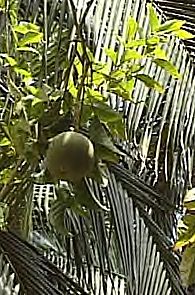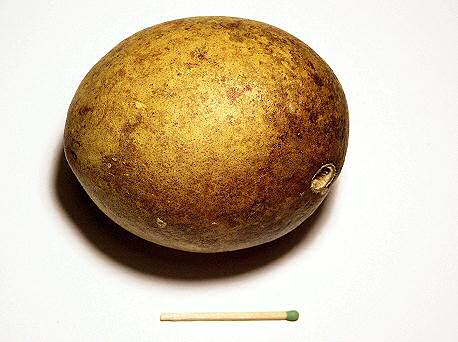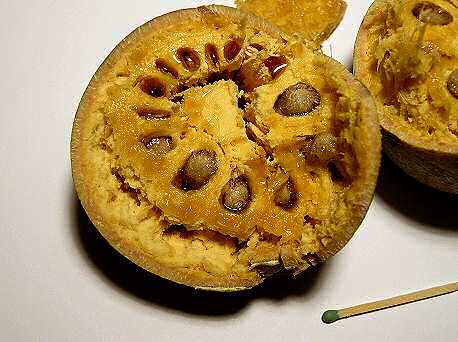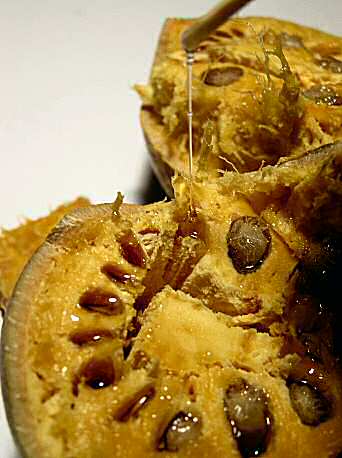Malabar-Orange
Aegle marmelos Correa oder Crataeva marmelos L.
(...see English version...)
Die Bael Frucht, Aegle marmelos Correa, auch genannt Bengal quince,
Indian quince, Goldapfel, heilige Frucht, Steinapfel, "Bel", "Sirphal", "Maredu"
in Indien; "Matum" und "Mapin" in Thailand; "Phneou oder "Pnoi" in Kambodscha;
"Bau nau" in Vietnam; "Bilak" oder "Maja pahit" in Malaysia; "Modjo" in Java;
"Malabar orange" in Frankreich.
Landestyp. Namen: Bael or bel fruit (En). Bel Indien (Fr). Indonesia: maja,
maja batu. Malaysia: bilak, bila, bel. Philippines: bael. Burma: opesheet,
okshit. Cambodia: bnau. Laos: toum. Thailand: matum, tum (Pattani), ma pin
(north). Vietnam: trái mam.
Die zu den Zitrusfrüchten gehörende Pflanze wächst wild in
den Trockenwäldern der indischen Halbinsel, Ceylons, Pakistans und in
Bangladeshs und in trockenen Palm-Mischwäldern von Kambodscha, Vietnam
und Laos. Es ist ein alter Kulturbaum, der häufig in Tempelgärten
zu sehen ist wurde. Er ist bis nach China, Südostasien (Thailand, Malaysia,
Java und Luzon) verbreitet.
 |
Die Malabar-"Orange"
noch grün am Baum |
ca. kartoffelgroß, Form wie Papaya, nur kleiner |
 |
 |
...die ca. 5mm dicke Schale ist hart wie Holz;
das Innere ist weich wie Käse und schmeckt wie Maracuja;
die Samen sind von einer Art glasig-klebrigem Schleim umgeben... |
...der sich zu einem Faden langziehen läßt und ähnlich
wie Gummi-Arabicum hervorragend Papier klebt...
Danke an Fr. Nicole Rast für das "Mitbringsel" aus Sri-Lanka
(Ceylon)! |
 |
|
|
Der zu den Zitrusfrüchten gehörende, mittelgroße, 12-15 Meter
hohe kurzstammige Baum ist langsamwachsend; Die Pflanze ist begrenzt forsthart
(bis -6°C) und hält auch Temperaturen von bis zu 48°C im Schatten
aus. Es kommt übrigens zu keiner Fruchtbildung wenn es zu keiner
Trockenperiode kommt.
Ein klarer Gummisaft, dem Gummi arabicum ähnlich tritt bei Verletzung
der Äste aus und hängt in langen Gebilden herunter und wird an
der Luft langsam hart. Ein ähnliches Phänomen ist uns in Deutschland
von Kirsch- und Pflaumenbäumen bekannt. In Mangelzeiten wurde Kirschgummi
übrigens auch bei uns gesanmmelt und als Kleber benutzt.
Die Frucht heißt Malabar-Orange, ist bei ca. 10cm Durchmesser rundoval
bis birnenförmig und hat eine dünnholzige graugrüne Schale,
die zur Reife gelblich wird und wie bei Zitrusfrüchten üblich mit
aromatisch duftenden Öldrüsen hat. Im Inneren findet sich eine
harte zentrale Zone, darum herum viele dreieckige Segmente mit dünnen
dunkelorange Wänden, die mit einem aromatischen, blassorangen,
pastösen, harzig-süß zusammenziehend schmeckenden Fruchtfleisch
gefüllt sind. In das Fruchtfleisch eingebettet sind bis zu 15
platt-längliche 1cm lange, haarige Samen, die in einen kleinen Beutel
klebrig durchsichtigen Schleim eingebettet sind, welcher an der Luft
erhärtet.
Die Verwendung der Pflanze ist recht vielseitig:
Zunächst ist das mit Palmzucker bestreute Fruchtfleisch in Indonesien
ein beliebtes Frühstück.
Das Fruchtfleisch hat eine gewisse schmutzlösende Wirkung und wird als
Seifenersatz zum Kleiderwaschen benutzt.
Die Schleimsubstanz die sich um die Samen unreifer Früchte befindet
wird als einheimischer Haushaltskleber "Dschungelkleber" verwendet.
Der Auszug der Blätter und jungen Früchten wurde in Java zum Strecken
bzw. Verfälschen von Opium benutzt. Ansonsten wird die Frucht fast reif
zerschnitten und getrocknet gegen Durchfälle und Darmbeschwerden angewandt.
Die Haut der unreifen Frucht dient zum gelb Färben und als Gerbstoff.
In Indochina werden die Baumrinde und Blätter gegen das Wechselfieber
(Malaria) beutzt; andererseits dient in Sulawesi die Rinde zum Vergiften
und Fangen von Fischen...
Junge Blätter werden in Java zum Würzen benutzt obgleich eine andere
Quelle diese als Ursache für Fehlgeburten und Sterilität bei Frauen
nennt...
Daneben werden sie zusammen mit Betelpfeffer und Kalk auf juckende Haut und
Wunden aufgetragen; bei Rindern dient der Blättersaft gegen Maul und
Klauenseuche.
Das Holz wird beispielsweise zu Griffen für die traditionellen indonesischen
Prunkdolche "Kris" benutzt.
Daneben wird der Fruchtgummi mit Kalkputz vermischt und macht diesen
wasserabweisend; auch Wasserfarben und Zement werden dadurch
wasserbeständiger.
Beim Drachenbau dient der Fruchtschleim wie oben erwähnt als Klebstoff
zum Aufkleben des Papiers auf das Drachengestell.
Anregungen, Kritik,
Fragen......?
...oder weitere wichtige
Pflanzen...?
...dann bitte
Mail
to Kite
Musical
Instruments!
Die noch fehlenden Pflanzenbilder werden nach und
nach ergänzt!
Falls jemand gute Pflanzenbilder hat,
würde ich sie hier gerne mit Nennung des Autors veröffentlichen;
Danke im Voraus!!)
Zurück mit dem "back"-button Ihres browsers
oder
zur Index-Seite der "Pflanzen für den
Drachenbau"...
oder
Zur
Hauptseite von Aeolian Musical Instruments
gestaltet und weiterentwickelt von
Uli
Wahl, all rights reserved
.
.
.
.
.
.
.
.
(...see English version...)
.
.
.
.
.
.
.
.
.
Bael-Fruit or
Malabar-Orange
Aegle marmelos Correa or Crataeva marmelos L.
(...siehe deutsche Version...)
The Bael-fruit, Aegle marmelos Correa, or also called bengal quince,
Indian quince (Engl.), Goldapfel, heilige Frucht, Steinapfel (Deu.), "Bel",
"Sirphal", "Maredu" in Indiea; "Matum" und "Mapin" in Thailand; "Phneou or
"Pnoi" in Cambodia; "Bau nau" in Viet Nam; "Bilak" or "Maja pahit" in Malaysia;
"Modjo" in Java; "Malabar orange" en France.
Vernacular names: Bael or bel fruit (En). Bel Indien (Fr). Indonesia: maja,
maja batu. Malaysia: bilak, bila, bel. Philippines: bael. Burma: opesheet,
okshit. Cambodia: bnau. Laos: toum. Thailand: matum, tum (Pattani), ma pin
(north). Vietnam: trái mam.
Belonging to the citrus fruit family, the plant grows wild in the dry-forests
of the Indian peninsula, Ceylon, Pakistan and in Bangladesh, in mixed dry
palm-forests of Cambodia, Viet Nam and Laos; it is an old culture-tree, which
can be often seen in temple gardens. It is widely found from China to South-East
Asia (Thailand, Malaysia, Java and Luzon).
 |
Bael-fruit still green
on the tree
(that with LEAVES, NOT the palm...) |
size like a potato, form like a Papaya, but smaller |
 |
 |
...its shell, ca. 5mm thick, is hard like wood;
when ripe, its pulp is smooth as cheese
and tastes a bit like Maracuja;
The seeds are enclosed by a viscous,
vitreous-sticky slime... |
...which can be "spun" to a filament and has gluing properties like "gum
arabic" (on stamps...)...
Thanks to Mrs.. Nicole Rast for this holiday-present from Sri-Lanka
(Ceylon)! |
 |
|
|
Belonging to the citrus fruit family this tree is slowly growing, up to 12-15
meters tall; the plant is limited frost-hard (to 6°C minus) and can
stand temperatures 48°C in the shadow. By the way, the plant refuses
fruiting when there is no dry period in climate.
A clear viscous, gummy juice, similar to gum arabic is exuded when twigs
are injured, hanging down in long icicle-like aggregates, slowly hardening
at the free air. A similar phenomenon we also know here in Germany from cherry-
and plum-trees. In times of shortage the cherry-gum was also collected and
used as glue.
The plant's fruit is called malabar-orange, has a diameter of about 10cm,
shaped round oval to pearlike and has a thin woody greygreen shell becoming
yellowish brown when ripe. Like in other citrus fruits, the fruit's skin
has a pleasant smell due to fragrant essential glands. Inside, there is a
hard central zone which is surrounded by many triangular segments with thin
walls colored dark orange. The segments contain an aromatic, pale-orange,
pasty, resinous-sweet adstringent tasting pulp. Embedded in the fruit-flesh
there are up to 15 flat-lengthy 1cm long, hairy seeds, which are enclosed
in a little sac by a viscous slime, which is hardening at the air.
The use of the plant is a multifold one:
At first, in Indonesia the pulp strewed with palm-sugar is a popular
breakfast.
The pulp has certain dirt-dissolving properties, so it is used as a substitute
for soap for washing clothes.
Called "jungle-glue", the slimy substance around the seeds of unripe fruits
is used as a cheap household glue.
An extract made of the leaves and young fruits was used for adulterating
opium in Java...
As a medical use, the unripe fruit is cut and dried acting against diarrhea
and intestine disorders.
The skin of the unripe Malabar-orange gives a good yellow dye and a valuable
tanning solution. In Indochina the bark and leaves are used against
Malaria-fever; in contrary in Sulawesi the bark is used for hunting/ poisoning
fish...
Young leaves serve as a spice in Java although an other source quotes the
leaves as an origin of sterility and abortion in women...
Together with betel-pepper and chalk it is put on itching skin and wounds;
the juice of leaves acts against foot-and-mouth disease of cattle.
The timber is made to the traditional Indonesian "Kris"-daggers.
Besides the fruit's gum is mixed with chalk-plaster making it waterproof;
water-colours and concrete also become more water-resistant.
As mentioned above the fruit's slime serves as a glue for fixing paper
or silk on the kite's frame.
Comments, criticism or
questions......?
...or some more important plants for
kites...?
...please
Mail
to Kite
Musical
Instruments!
Some plant-pictures are still lacking and will be
completed by and by!
In case someone has good pictures,
I'd like to publish them here together with the author's name;
Thanks in advance!!
Go back with the "back"-button of your browser
or
goto the index page of "Plants for Kite-Building"...
or
goto
main-page of Aeolian Musical Instruments
created and completed by
Uli
Wahl, all rights reserved



